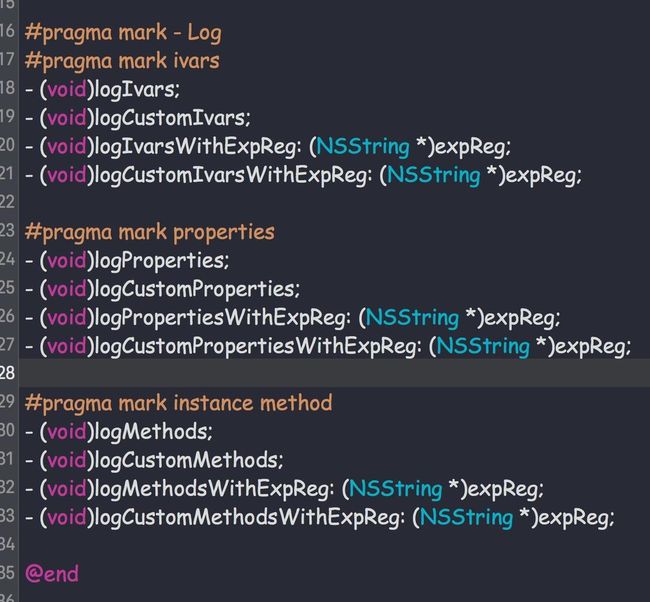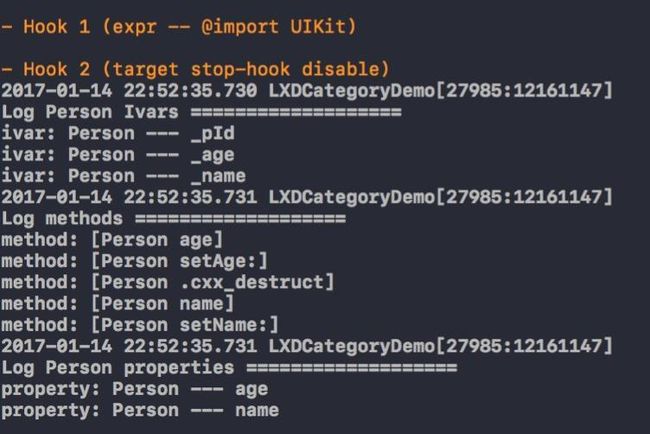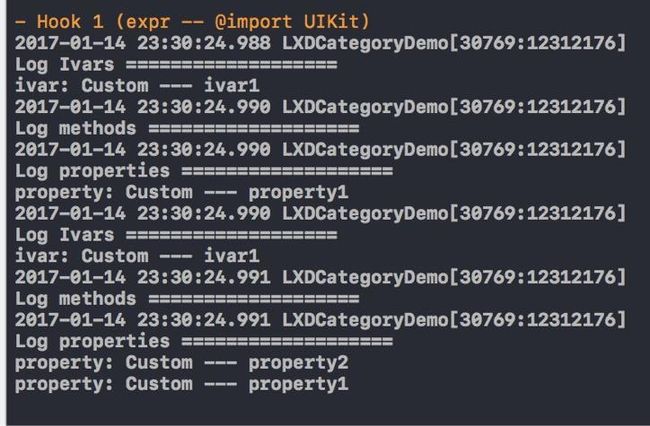前言
前几天有人问我一个问题:为什么分类不能自动创建get set方法。老实说,笔者从来没有去思考过这个问题。于是这次通过代码实践跟runtime源码来探究这个问题。
准备工作
为了能减少输出类数据的代码工作,笔者基于NSObject的分类封装了一套代码
其中输出类实例变量的具体代码:
- (void)logIvarsWithExpReg: (NSString *)expReg customed: (BOOL)customed {
[NSObject kRecordOBJ];
unsigned int ivarCount; Ivar * ivars = class_copyIvarList([self class], &ivarCount); for (int idx = 0; idx < ivarCount; idx++) { Ivar ivar = ivars[idx]; NSString * ivarName = [NSString stringWithUTF8String: ivar_getName(ivar)]; if (customed && [kOBJIvarNames containsObject: ivarName]) { continue; } if (expReg && !kValidExpReg(ivarName, expReg)) { continue; } printf("ivar: %s --- %s\n", NSStringFromClass([self class]).UTF8String, ivarName.UTF8String); } free(ivars); }+(void)kRecordOBJ采用dispatch_once的方式将NSObject存在的数据存储到三个数组中,用来排除父类的数据输出
类的属性
-
正常创建类
@interface Person: NSObject { int _pId; } @property (nonatomic, copy) NSString * name; @property (nonatomic, assign) NSUInteger age; @end int main(int argc, char * argv[]) { @autoreleasepool { Person * p = [[Person alloc] init]; [p logCustomIvars]; [p logCustomMethods]; [p logCustomProperties]; return UIApplicationMain(argc, argv, nil, NSStringFromClass([AppDelegate class])); } }运行结果:属性
name和age生成了对应的_propertyName的实例变量以及setter和getter -
动态生成属性
age@implementation Person @dynamic age; @end运行结果:缺少了
_age变量以及对应的setAge:和age方法 -
手动实现
setter/getter@implemetation Person @dynamic age; - (void)setAge: (NSUInteger)age {} - (NSUInteger)age { return 18; } @end输出结果:未生成
_age实例变量 -
手动实现
_pId的setter/getter@implemetation Person @dynamic age; - (void)setAge: (NSUInteger)age {} - (NSUInteger)age { return 18; } - (void)setPId: (int)pId { _pId = pId; } - (int)pId { return _pId; } @end [p setValueForKey: @"pId"];运行结果:
KVC的访问会触发setter方法,_pId除了无法通过点语法访问外,其他表现与@property无异
通过上面的几段试验,可以得出@property的公式:
分类属性
-
分类中添加
weigh和height属性@interface Person (category) @property (nonatomic, assign) CGFloat weigh; @property (nonatomic, assign) CGFloat height; @end运行结果:
weigh和height未生成实例变量以及对应的setter/getter,与@dynamic修饰的age表现一致 -
使用
@synthesize自动合成setter/getter方法时编译报错 -
手动实现
setter/getter
@implemetation Person (category)- (void)setWeigh: (CGFloat)weigh {} - (CGFloat)weigh { return 150; } @end运行结果:与
@dynamic age后重写其setter/getter表现一致 -
动态绑定属性来实现
setter/gettervoid * kHeightKey = &kHeightKey; @implemetation Person (category) - (void)setWeigh: (CGFloat)weigh {} - (CGFloat)weigh { return 150; } - (void)setHeight: (CGFloat)height { objc_setAssociatedObject(self, kHeightKey, @(height), OBJC_ASSOCIATION_RETAIN_NONATOMIC); } - (CGFloat)height { return return [objc_getAssociatedObject(self, kHeightKey) doubleValue];; } @end [p logCustomIvars] [p logCustomMethods]; [p logCustomProperties]; CGFloat height = 180; p.height = 180; height = p.height; [p logCustomIvars] [p logCustomMethods]; [p logCustomProperties];运行结果:动态绑定前后
ivar没有发生任何变化
通过代码实验,可以得出下面两个结论:
- 分类属性相当于
@dynamic property - 缺少
ivar的情况下无法使用@synthesize自动合成属性
以及一个猜想:
- 在类完成加载后无法继续添加
ivar
通过runtime动态创建类验证猜想:
int main(int argc, char * argv[]) {
NSString * className = @"Custom";
Class customClass = objc_allocateClassPair([NSObject class], className.UTF8String, 0);
class_addIvar(customClass, @"ivar1".UTF8String, sizeof(NSString *), 0, "@"); objc_property_attribute_t type1 = { "T", "@\"NSString\"" }; objc_property_attribute_t ownership1 = { "C", "N" }; objc_property_attribute_t atts1[] = { type1, ownership1 }; class_addProperty(customClass, "property1", atts1, 2); objc_registerClassPair(customClass); id instance = [[customClass alloc] init]; NSLog(@"\nLog Ivars ==================="); [instance logCustomIvars]; NSLog(@"\nLog methods ==================="); [instance logCustomMethods]; NSLog(@"\nLog properties ==================="); [instance logCustomProperties]; class_addIvar(customClass, @"ivar2".UTF8String, sizeof(NSString *), 0, "@"); objc_property_attribute_t type2 = { "T", "@\"NSString\"" }; objc_property_attribute_t ownership2 = { "C", "N" }; objc_property_attribute_t atts2[] = { type2, ownership2 }; class_addProperty(customClass, "property2", atts2, 2); instance = [[customClass alloc] init]; NSLog(@"\nLog Ivars ==================="); [instance logCustomIvars]; NSLog(@"\nLog methods ==================="); [instance logCustomMethods]; NSLog(@"\nLog properties ==================="); [instance logCustomProperties]; }运行结果:在调用class_registerClassPair后,添加ivar失败
从源码解析
objc_class的结构体定义如下:
struct objc_class : objc_object {
Class superclass;
const char *name; uint32_t version; uint32_t info; uint32_t instance_size; struct old_ivar_list *ivars; struct old_method_list **methodLists; Cache cache; struct old_protocol_list *protocols; // CLS_EXT only const uint8_t *ivar_layout; struct old_class_ext *ext; }ps: 在新版本中结构体内部已经发生了大改,但是内部的属性大致上仍是这些
这里面有个重要的属性ivar_layout,顾名思义存放的是变量的位置属性,与之对应的还有一个weakIvarLayout变量,不过在默认结构中没有出现。这两个属性用来记录ivar哪些是strong或者weak,而这个记录操作在runtime阶段已经被确定好。正由于如此,这极有可能是ivar无法在类被加载后继续添加的原因之一。ivar_layout的更多了解可以参照Objective-C Class Ivar layout一文
import操作帮助编译检查和链接过程,但是在category的加载过程中,不会将扩展的内容添加到原始的类结构中。runtime对于category的加载过程可以简单的分成下面几步(摘自objc category的密码):
objc runtime的加载入口是一个叫_objc_init的方法,在library加载前由libSystem dyld调用,进行初始化操作- 调用
map_images方法将文件中的imagemap到内存 - 调用
_read_images方法初始化map后的image,这里面干了很多的事情,像load所有的类、协议和category,著名的+ load方法就是这一步调用的
-仔细看category的初始化,循环调用了_getObjc2CategoryList方法,这个方法拿出来看看: - .…
这一切的过程发生在_objc_init函数中,函数实现如下
简单来说在load_images函数中最终会走到下面的代码调用来加载所有的类以及类的分类
根据上面的代码加上runtime的加载顺序,可以继续推出:
-
@dynamic实际上是将属性的加载推迟到类加载完成后
另外,前面也说过在缺少ivar的情况下无法自动合成setter/getter,除了category本身是不被添加到类结构中的,所以无法使用类结构的ivar合成属性外,还有分类自身结构的问题
struct category_t {
const char *name; /// 类名 classref_t cls; /// 类指针 struct method_list_t *instanceMethods; /// 实例方法 struct method_list_t *classMethods; /// 类方法 struct protocol_list_t *protocols; /// 扩展的协议 struct property_list_t *instanceProperties; /// 扩展属性 method_list_t *methodsForMeta(bool isMeta) { ... } property_list_t *propertiesForMeta(bool isMeta) { ... } };可以看到分类结构本身是不存在ivar的容器的,因此缺少了自动合成属性的条件。最后还有一个问题,我们在使用objc_associate系列函数绑定属性的时候这些变量存储在了哪里?
总结
首先,iOS的分类在runtime实现的结构体中并不存在Ivar类型的容器,缺少了自动合成setter以及getter的必要条件,因此在分类中声明的属性默认为@dynamic修饰。
其次,OC本身是一门原型语言,对象和类原型很像。类对象执行alloc方法就像是原型模式中的copy操作一样,类保存了copy所需的实例信息,这些信息内存信息在runtime加载时就被固定了,没有扩充Ivar的条件。(感谢大表哥的科普)
最后,在runtime中存在一个类型为AssociationHashMap的哈希映射表保存着对象动态添加的属性,每个对象以自身地址为key维护着一个绑定属性表,我们动态添加的属性就都存储在这个表里,这也是动态添加property能成功的基础。
作者:sindri的小巢
链接:http://www.jianshu.com/p/dcc3284b65bf
來源:简书
著作权归作者所有。商业转载请联系作者获得授权,非商业转载请注明出处。












